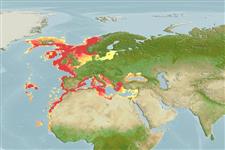Teleostei (teleosts) >
Anguilliformes (Eels and morays) >
Congridae (Conger and garden eels) > Congrinae
Etymology: Conger: Latin, conger = conger (Ref. 45335).
More on author: Linnaeus.
Environment: milieu / climate zone / depth range / distribution range
Ecology
Marine; demersal; oceanodromous (Ref. 51243); depth range 0 - 1171 m (Ref. 56504). Temperate; 68°N - 12°N, 32°W - 42°E
Eastern Atlantic: Norway and Iceland to Senegal. Also in the Mediterranean and Black Sea.
Length at first maturity / Size / Weight / Age
Maturity: Lm 200.0 range ? - ? cm
Max length : 300 cm TL male/unsexed; (Ref. 4453); common length : 100.0 cm TL male/unsexed; (Ref. 4645); common length :150 cm TL (female); max. published weight: 110.0 kg (Ref. 35388)
Found on rocky and sandy bottoms (Ref. 12382). Depth range from 0-500 m (Ref. 4453) and from 305-1171 m in the eastern Ionian Sea (Ref. 56504). It stays near the coast when young and moves toward deeper waters upon reaching adulthood (Ref. 5377). A nocturnal (Ref. 12382) predator of fish, crustaceans, and cephalopods (Ref. 6521). Like other species of the group, it reproduces only once in its life (Ref. 5377). Sexually mature at an age of 5-15 years. Spawn in summer in the Atlantic off Portugal and in the Mediterranean. Produces 3-8 million of eggs (Ref. 35388). Marketed fresh and frozen. Eaten fried and baked (Ref. 9988).
Eggs are deposited in the open sea, at depths between 2,000 and 3,000 m (Ref. 12382).
Smith, D.G., 1990. Congridae. p. 156-167. In J.C. Quero, J.C. Hureau, C. Karrer, A. Post and L. Saldanha (eds.) Check-list of the fishes of the eastern tropical Atlantic (CLOFETA). JNICT, Lisbon; SEI, Paris; and UNESCO, Paris. Vol. 1. (Ref. 4453)
IUCN Red List Status (Ref. 130435: Version 2024-1)
Threat to humans
Reports of ciguatera poisoning (Ref. 30911)
Human uses
Fisheries: commercial; gamefish: yes; aquarium: public aquariums
Tools
Special reports
Download XML
Internet sources
Estimates based on models
Preferred temperature (Ref.
123201): 4.4 - 14.4, mean 8.7 °C (based on 480 cells).
Phylogenetic diversity index (Ref.
82804): PD
50 = 0.5000 [Uniqueness, from 0.5 = low to 2.0 = high].
Bayesian length-weight: a=0.00046 (0.00035 - 0.00059), b=3.26 (3.20 - 3.32), in cm total length, based on LWR estimates for this species (Ref.
93245).
Trophic level (Ref.
69278): 4.3 ±0.4 se; based on diet studies.
Generation time: 17.4 ( na - na) years. Estimated as median ln(3)/K based on 1
growth studies.
Resilience (Ref.
120179): Low, minimum population doubling time 4.5 - 14 years (K=0.06; tm=5-15 (female tm>10); Fec=3,000,000).
Prior r = 0.35, 95% CL = 0.23 - 0.53, Based on 7 data-limited stock assessments.
Fishing Vulnerability (Ref.
59153): Very high vulnerability (86 of 100).
Climate Vulnerability (Ref.
125649): Moderate vulnerability (38 of 100).
Nutrients (Ref.
124155): Calcium = 10.9 [6.6, 19.9] mg/100g; Iron = 0.259 [0.148, 0.441] mg/100g; Protein = 18.2 [15.3, 21.1] %; Omega3 = 0.482 [0.219, 1.328] g/100g; Selenium = 39.3 [20.9, 74.7] μg/100g; VitaminA = 8.33 [2.17, 33.01] μg/100g; Zinc = 0.278 [0.200, 0.398] mg/100g (wet weight); based on
nutrient studies.
